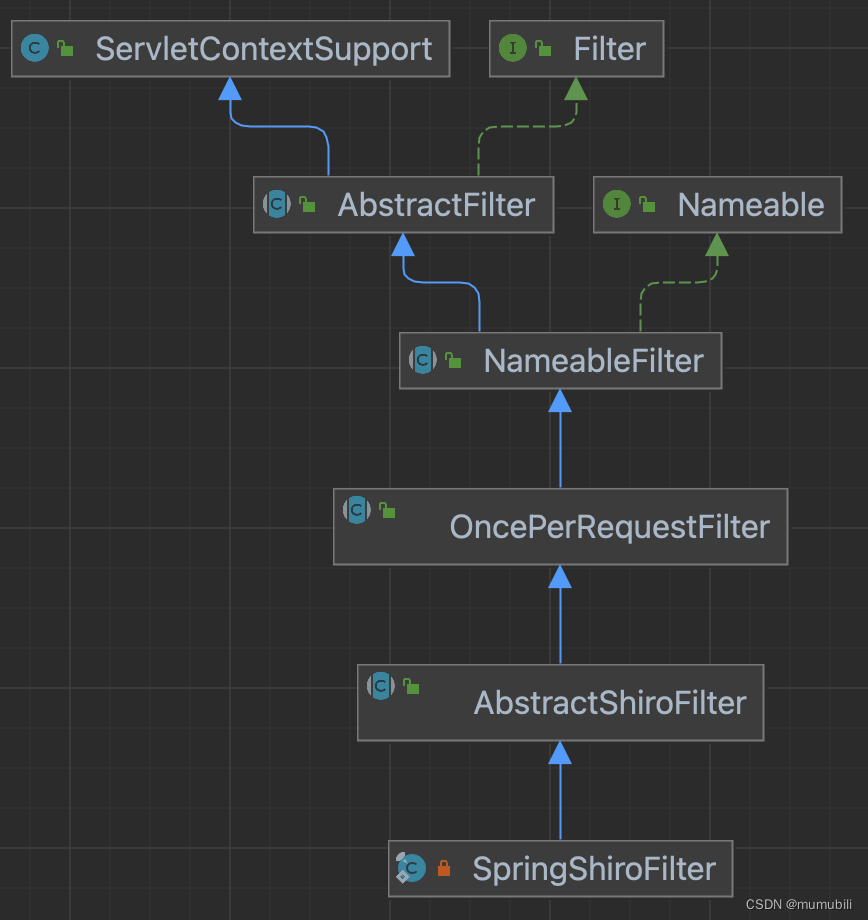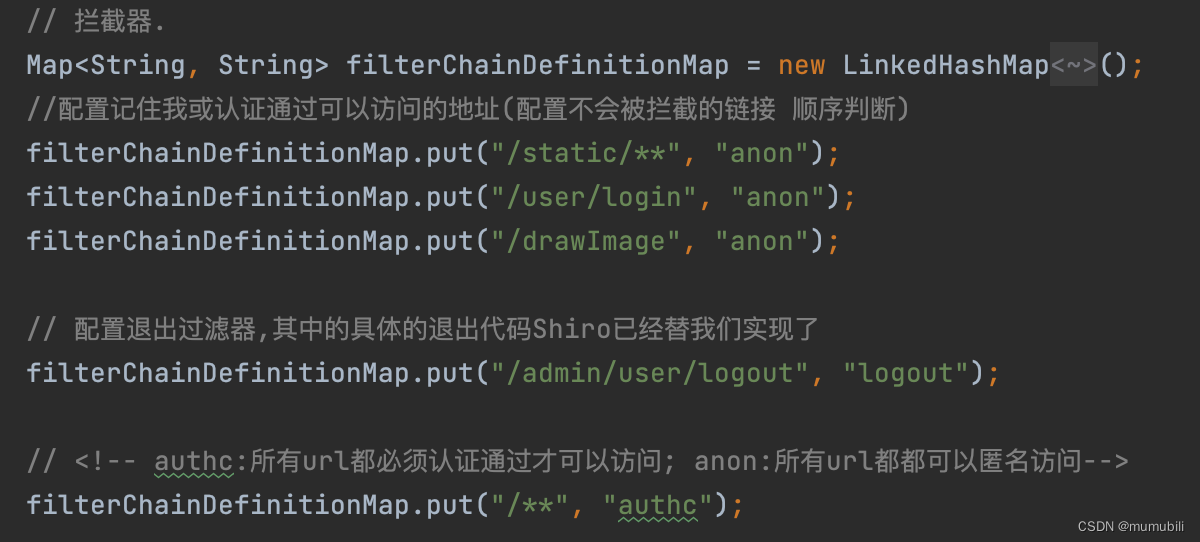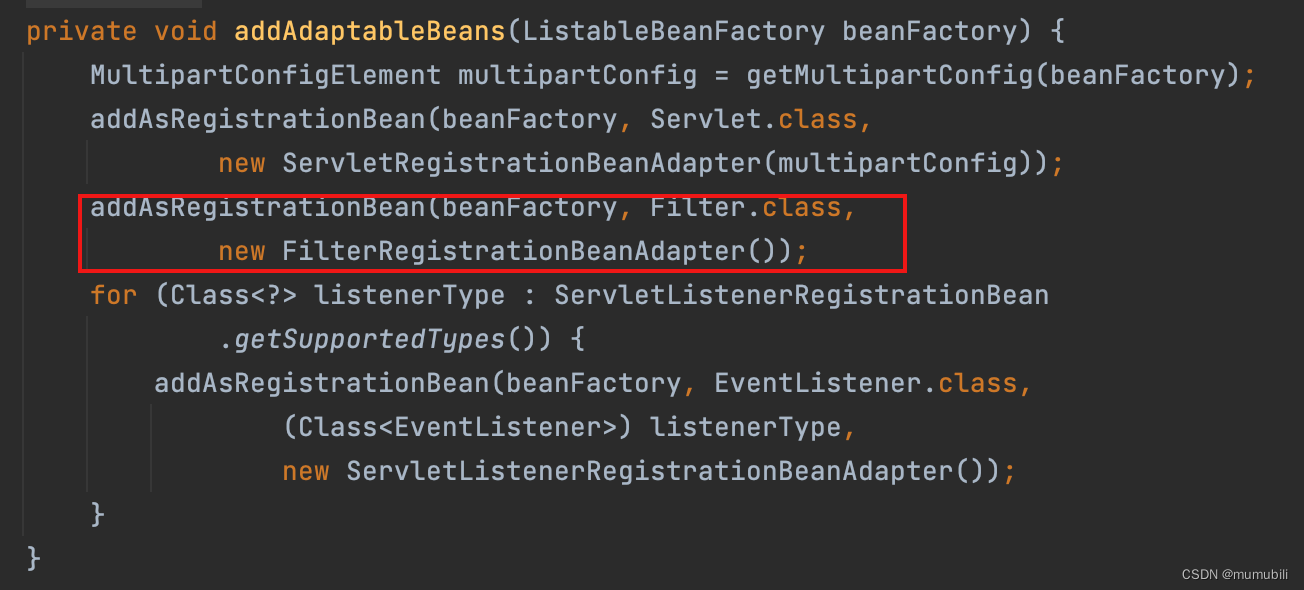目录
1.Shiro自定义拦截器SpringShiroFilter
1.1 ShiroFilterFactoryBean解析
1.1.1 实现FactoryBean接口
1.1.2 实现BeanPostProcessor接口
1.2 SpringShiroFilter解析
1.2.1 OncePerRequestFilter过滤逻辑实现
1.2.2 AbstractShiroFilter过滤逻辑实现
1.2.2.1 创建Subject对象
1.2.2.2 更新Session最后访问时间
1.2.2.3 执行过滤链
1.2.2.3.1 构造过滤链
1.2.2.3.2 执行构造好的过滤链
2.SpringShiroFilter如何添加到Servlet Filter中
2.1 常见的添加Servlet Filter方式
2.1.1 方式一:显示定义FilterRegistrationBean
2.1.2 方式二:显示定义ShiroFilterFactoryBean
2.2 添加Servlet Filter方式源码解析
2.2.1 addServletContextInitializerBeans
2.2.2 addAdaptableBeans
Shiro通过添加Servlet Filter的方式,提供了登录验证(Authentication)、访问控制(Authorization)以及Session管理等功能,极大的简化了Spring项目中登录鉴权模块的开发工作。
下面通过ShiroFilterFactoryBean作为切入点,详细分析下自定义拦截器SpringShiroFilter的处理流程;并通过源码解析,跟踪SpringShiroFilter是如何添加到Servlet Filter中的;
1.Shiro自定义拦截器SpringShiroFilter
SpringShiroFilter的初始化和构造逻辑是ShiroFilterFactoryBean完成的,首先看一下ShiroFilterFactoryBean的处理逻辑;
1.1 ShiroFilterFactoryBean解析

ShiroFilterFactoryBean同时实现了FactoryBean和BeanPostProcessor接口,因此其具体实现也包含了这2部分功能,下面分别进行说明;
1.1.1 实现FactoryBean接口
/*** Lazily creates and returns a {@link AbstractShiroFilter} concrete instance via the* {@link #createInstance} method.** @return the application's Shiro Filter instance used to filter incoming web requests.* @throws Exception if there is a problem creating the {@code Filter} instance.*/public Object getObject() throws Exception {if (instance == null) {instance = createInstance();}return instance;}/*** Returns <code>{@link org.apache.shiro.web.servlet.AbstractShiroFilter}.class</code>** @return <code>{@link org.apache.shiro.web.servlet.AbstractShiroFilter}.class</code>*/public Class getObjectType() {return SpringShiroFilter.class;}/*** Returns {@code true} always. There is almost always only ever 1 Shiro {@code Filter} per web application.** @return {@code true} always. There is almost always only ever 1 Shiro {@code Filter} per web application.*/public boolean isSingleton() {return true;}/*** This implementation:* <ol>* <li>Ensures the required {@link #setSecurityManager(org.apache.shiro.mgt.SecurityManager) securityManager}* property has been set</li>* <li>{@link #createFilterChainManager() Creates} a {@link FilterChainManager} instance that reflects the* configured {@link #setFilters(java.util.Map) filters} and* {@link #setFilterChainDefinitionMap(java.util.Map) filter chain definitions}</li>* <li>Wraps the FilterChainManager with a suitable* {@link org.apache.shiro.web.filter.mgt.FilterChainResolver FilterChainResolver} since the Shiro Filter* implementations do not know of {@code FilterChainManager}s</li>* <li>Sets both the {@code SecurityManager} and {@code FilterChainResolver} instances on a new Shiro Filter* instance and returns that filter instance.</li>* </ol>** @return a new Shiro Filter reflecting any configured filters and filter chain definitions.* @throws Exception if there is a problem creating the AbstractShiroFilter instance.*/protected AbstractShiroFilter createInstance() throws Exception {log.debug("Creating Shiro Filter instance.");SecurityManager securityManager = getSecurityManager();if (securityManager == null) {String msg = "SecurityManager property must be set.";throw new BeanInitializationException(msg);}if (!(securityManager instanceof WebSecurityManager)) {String msg = "The security manager does not implement the WebSecurityManager interface.";throw new BeanInitializationException(msg);}FilterChainManager manager = createFilterChainManager();//Expose the constructed FilterChainManager by first wrapping it in a// FilterChainResolver implementation. The AbstractShiroFilter implementations// do not know about FilterChainManagers - only resolvers:PathMatchingFilterChainResolver chainResolver = new PathMatchingFilterChainResolver();chainResolver.setFilterChainManager(manager);//Now create a concrete ShiroFilter instance and apply the acquired SecurityManager and built//FilterChainResolver. It doesn't matter that the instance is an anonymous inner class//here - we're just using it because it is a concrete AbstractShiroFilter instance that accepts//injection of the SecurityManager and FilterChainResolver:return new SpringShiroFilter((WebSecurityManager) securityManager, chainResolver);}protected FilterChainManager createFilterChainManager() {DefaultFilterChainManager manager = new DefaultFilterChainManager();Map<String, Filter> defaultFilters = manager.getFilters();//apply global settings if necessary:for (Filter filter : defaultFilters.values()) {applyGlobalPropertiesIfNecessary(filter);}//Apply the acquired and/or configured filters:Map<String, Filter> filters = getFilters();if (!CollectionUtils.isEmpty(filters)) {for (Map.Entry<String, Filter> entry : filters.entrySet()) {String name = entry.getKey();Filter filter = entry.getValue();applyGlobalPropertiesIfNecessary(filter);if (filter instanceof Nameable) {((Nameable) filter).setName(name);}//'init' argument is false, since Spring-configured filters should be initialized//in Spring (i.e. 'init-method=blah') or implement InitializingBean:manager.addFilter(name, filter, false);}}//build up the chains:Map<String, String> chains = getFilterChainDefinitionMap();if (!CollectionUtils.isEmpty(chains)) {for (Map.Entry<String, String> entry : chains.entrySet()) {String url = entry.getKey();String chainDefinition = entry.getValue();manager.createChain(url, chainDefinition);}}return manager;}如上,通过初始化SecurityManager,DefaultFilterChainManager以及PathMatchingFilterChainResolver,完成了SpringShiroFilter的单例构造;
1.1.2 实现BeanPostProcessor接口
/*** Inspects a bean, and if it implements the {@link Filter} interface, automatically adds that filter* instance to the internal {@link #setFilters(java.util.Map) filters map} that will be referenced* later during filter chain construction.*/public Object postProcessBeforeInitialization(Object bean, String beanName) throws BeansException {if (bean instanceof Filter) {log.debug("Found filter chain candidate filter '{}'", beanName);Filter filter = (Filter) bean;applyGlobalPropertiesIfNecessary(filter);getFilters().put(beanName, filter);} else {log.trace("Ignoring non-Filter bean '{}'", beanName);}return bean;}/*** Does nothing - only exists to satisfy the BeanPostProcessor interface and immediately returns the* {@code bean} argument.*/public Object postProcessAfterInitialization(Object bean, String beanName) throws BeansException {return bean;}在postProcessBeforeInitialization方法中,通过拦截Filter类型的bean,完成全局属性的注入,包括设置:loginUrl、successUrl、unauthorizedUrl;
1.2 SpringShiroFilter解析
SpringShiroFilter类继承结构如下,实现了顶层接口Servlet Filter,因此SpringShiroFilter作为Shiro实现的自定义Filter实现,可以注册到Servlet Filter中执行过滤器逻辑(第2部分进行具体说明);

在如上的继承层次结构中:
-
Filter作为Servlet过滤器顶层接口,声明了doFilter过滤方法
/* @param request The request to process* @param response The response associated with the request* @param chain Provides access to the next filter in the chain for this* filter to pass the request and response to for further* processing** @throws IOException if an I/O error occurs during this filter's* processing of the request* @throws ServletException if the processing fails for any other reason*/public void doFilter(ServletRequest request, ServletResponse response,FilterChain chain) throws IOException, ServletException;- AbstractFilter抽象类支持FilterConfig初始化
- NameableFilter实现了Nameable,内部实现主要完成了过滤器name的解析
- OncePerRequestFilter见名知意,实现了“单次请求,一次过滤”的语义
- AbstractShiroFilter通过注入WebSecurityManager和FilterChainResolver完成Shiro内部的过滤处理逻辑
下面着重分析下doFilter方法在OncePerRequestFilter和AbstractShiroFilter的过滤逻辑实现;
1.2.1 OncePerRequestFilter过滤逻辑实现
为了实现“单次请求,一次过滤”的语义,OncePerRequestFilter的过滤逻辑中是通过在ServletRequest中记录标志位属性值的方式实现的:
通过判断ServletRequest中是否已经设置了属性Key为alreadyFilteredAttributeName值的方式,判断该filter是否已经执行了过滤逻辑,已执行则跳过,未执行则执行过滤;
并通过引入抽象方法doFilterInternal完成内部过滤逻辑,交由子类具体实现;
具体过滤逻辑实现如下:
/*** This {@code doFilter} implementation stores a request attribute for* "already filtered", proceeding without filtering again if the* attribute is already there.** @see #getAlreadyFilteredAttributeName* @see #shouldNotFilter* @see #doFilterInternal*/public final void doFilter(ServletRequest request, ServletResponse response, FilterChain filterChain)throws ServletException, IOException {String alreadyFilteredAttributeName = getAlreadyFilteredAttributeName();if ( request.getAttribute(alreadyFilteredAttributeName) != null ) {log.trace("Filter '{}' already executed. Proceeding without invoking this filter.", getName());filterChain.doFilter(request, response);} else //noinspection deprecationif (/* added in 1.2: */ !isEnabled(request, response) ||/* retain backwards compatibility: */ shouldNotFilter(request) ) {log.debug("Filter '{}' is not enabled for the current request. Proceeding without invoking this filter.",getName());filterChain.doFilter(request, response);} else {// Do invoke this filter...log.trace("Filter '{}' not yet executed. Executing now.", getName());request.setAttribute(alreadyFilteredAttributeName, Boolean.TRUE);try {doFilterInternal(request, response, filterChain);} finally {// Once the request has finished, we're done and we don't// need to mark as 'already filtered' any more.request.removeAttribute(alreadyFilteredAttributeName);}}}/*** Return name of the request attribute that identifies that a request has already been filtered.* <p/>* The default implementation takes the configured {@link #getName() name} and appends "{@code .FILTERED}".* If the filter is not fully initialized, it falls back to the implementation's class name.** @return the name of the request attribute that identifies that a request has already been filtered.* @see #getName* @see #ALREADY_FILTERED_SUFFIX*/protected String getAlreadyFilteredAttributeName() {String name = getName();if (name == null) {name = getClass().getName();}return name + ALREADY_FILTERED_SUFFIX;}1.2.2 AbstractShiroFilter过滤逻辑实现
继承了抽象类OncePerRequestFilter,并实现了方法doFilterInternal完成具体Shiro具体过滤逻辑嵌入,具体实现如下:
/*** {@code doFilterInternal} implementation that sets-up, executes, and cleans-up a Shiro-filtered request. It* performs the following ordered operations:* <ol>* <li>{@link #prepareServletRequest(ServletRequest, ServletResponse, FilterChain) Prepares}* the incoming {@code ServletRequest} for use during Shiro's processing</li>* <li>{@link #prepareServletResponse(ServletRequest, ServletResponse, FilterChain) Prepares}* the outgoing {@code ServletResponse} for use during Shiro's processing</li>* <li> {@link #createSubject(javax.servlet.ServletRequest, javax.servlet.ServletResponse) Creates} a* {@link Subject} instance based on the specified request/response pair.</li>* <li>Finally {@link Subject#execute(Runnable) executes} the* {@link #updateSessionLastAccessTime(javax.servlet.ServletRequest, javax.servlet.ServletResponse)} and* {@link #executeChain(javax.servlet.ServletRequest, javax.servlet.ServletResponse, javax.servlet.FilterChain)}* methods</li>* </ol>* <p/>* The {@code Subject.}{@link Subject#execute(Runnable) execute(Runnable)} call in step #4 is used as an* implementation technique to guarantee proper thread binding and restoration is completed successfully.** @param servletRequest the incoming {@code ServletRequest}* @param servletResponse the outgoing {@code ServletResponse}* @param chain the container-provided {@code FilterChain} to execute* @throws IOException if an IO error occurs* @throws javax.servlet.ServletException if an Throwable other than an IOException*/protected void doFilterInternal(ServletRequest servletRequest, ServletResponse servletResponse, final FilterChain chain)throws ServletException, IOException {Throwable t = null;try {final ServletRequest request = prepareServletRequest(servletRequest, servletResponse, chain);final ServletResponse response = prepareServletResponse(request, servletResponse, chain);final Subject subject = createSubject(request, response);//noinspection uncheckedsubject.execute(new Callable() {public Object call() throws Exception {updateSessionLastAccessTime(request, response);executeChain(request, response, chain);return null;}});} catch (ExecutionException ex) {t = ex.getCause();} catch (Throwable throwable) {t = throwable;}if (t != null) {if (t instanceof ServletException) {throw (ServletException) t;}if (t instanceof IOException) {throw (IOException) t;}//otherwise it's not one of the two exceptions expected by the filter method signature - wrap it in one:String msg = "Filtered request failed.";throw new ServletException(msg, t);}}过滤逻辑主要包含了如下几部分:
- 创建Subject对象,标识系统登录用户
- 更新Session最后访问时间
- 执行过滤链
下面分别进行说明:
1.2.2.1 创建Subject对象
创建Subject对象底层是通过securityManager完成的,具体实现如下:
public Subject buildSubject() {return this.securityManager.createSubject(this.subjectContext);}public Subject createSubject(SubjectContext subjectContext) {//create a copy so we don't modify the argument's backing map:SubjectContext context = copy(subjectContext);//ensure that the context has a SecurityManager instance, and if not, add one:context = ensureSecurityManager(context);//Resolve an associated Session (usually based on a referenced session ID), and place it in the context before//sending to the SubjectFactory. The SubjectFactory should not need to know how to acquire sessions as the//process is often environment specific - better to shield the SF from these details:context = resolveSession(context);//Similarly, the SubjectFactory should not require any concept of RememberMe - translate that here first//if possible before handing off to the SubjectFactory:context = resolvePrincipals(context);Subject subject = doCreateSubject(context);//save this subject for future reference if necessary://(this is needed here in case rememberMe principals were resolved and they need to be stored in the//session, so we don't constantly rehydrate the rememberMe PrincipalCollection on every operation).//Added in 1.2:save(subject);return subject;}其中doCreateSubject方法委托给DefaultWebSubjectFactory完成Subject创建
public class DefaultWebSubjectFactory extends DefaultSubjectFactory {public DefaultWebSubjectFactory() {super();}public Subject createSubject(SubjectContext context) {if (!(context instanceof WebSubjectContext)) {return super.createSubject(context);}WebSubjectContext wsc = (WebSubjectContext) context;SecurityManager securityManager = wsc.resolveSecurityManager();Session session = wsc.resolveSession();boolean sessionEnabled = wsc.isSessionCreationEnabled();PrincipalCollection principals = wsc.resolvePrincipals();boolean authenticated = wsc.resolveAuthenticated();String host = wsc.resolveHost();ServletRequest request = wsc.resolveServletRequest();ServletResponse response = wsc.resolveServletResponse();return new WebDelegatingSubject(principals, authenticated, host, session, sessionEnabled,request, response, securityManager);}1.2.2.2 更新Session最后访问时间
记录Session最后访问时间,
- 如果是HttpSession,直接返回
- 如果是Native Session,也即Shiro创建的Session,通过touch方法更新最后访问时间
/*** Updates any 'native' Session's last access time that might exist to the timestamp when this method is called.* If native sessions are not enabled (that is, standard Servlet container sessions are being used) or there is no* session ({@code subject.getSession(false) == null}), this method does nothing.* <p/>This method implementation merely calls* <code>Session.{@link org.apache.shiro.session.Session#touch() touch}()</code> on the session.** @param request incoming request - ignored, but available to subclasses that might wish to override this method* @param response outgoing response - ignored, but available to subclasses that might wish to override this method* @since 1.0*/@SuppressWarnings({"UnusedDeclaration"})protected void updateSessionLastAccessTime(ServletRequest request, ServletResponse response) {if (!isHttpSessions()) { //'native' sessionsSubject subject = SecurityUtils.getSubject();//Subject should never _ever_ be null, but just in case:if (subject != null) {Session session = subject.getSession(false);if (session != null) {try {session.touch();} catch (Throwable t) {log.error("session.touch() method invocation has failed. Unable to update" +"the corresponding session's last access time based on the incoming request.", t);}}}}}1.2.2.3 执行过滤链
该部分具体实现如下,其主要包含了2个步骤:
- 构造过滤链
- 执行构造好的过滤链
下面分别进行说明
/*** Executes a {@link FilterChain} for the given request.* <p/>* This implementation first delegates to* <code>{@link #getExecutionChain(javax.servlet.ServletRequest, javax.servlet.ServletResponse, javax.servlet.FilterChain) getExecutionChain}</code>* to allow the application's Shiro configuration to determine exactly how the chain should execute. The resulting* value from that call is then executed directly by calling the returned {@code FilterChain}'s* {@link FilterChain#doFilter doFilter} method. That is:* <pre>* FilterChain chain = {@link #getExecutionChain}(request, response, origChain);* chain.{@link FilterChain#doFilter doFilter}(request,response);</pre>** @param request the incoming ServletRequest* @param response the outgoing ServletResponse* @param origChain the Servlet Container-provided chain that may be wrapped further by an application-configured* chain of Filters.* @throws IOException if the underlying {@code chain.doFilter} call results in an IOException* @throws ServletException if the underlying {@code chain.doFilter} call results in a ServletException* @since 1.0*/protected void executeChain(ServletRequest request, ServletResponse response, FilterChain origChain)throws IOException, ServletException {FilterChain chain = getExecutionChain(request, response, origChain);chain.doFilter(request, response);}1.2.2.3.1 构造过滤链
构造过滤链的逻辑如下:
/*** Returns the {@code FilterChain} to execute for the given request.* <p/>* The {@code origChain} argument is the* original {@code FilterChain} supplied by the Servlet Container, but it may be modified to provide* more behavior by pre-pending further chains according to the Shiro configuration.* <p/>* This implementation returns the chain that will actually be executed by acquiring the chain from a* {@link #getFilterChainResolver() filterChainResolver}. The resolver determines exactly which chain to* execute, typically based on URL configuration. If no chain is returned from the resolver call* (returns {@code null}), then the {@code origChain} will be returned by default.** @param request the incoming ServletRequest* @param response the outgoing ServletResponse* @param origChain the original {@code FilterChain} provided by the Servlet Container* @return the {@link FilterChain} to execute for the given request* @since 1.0*/protected FilterChain getExecutionChain(ServletRequest request, ServletResponse response, FilterChain origChain) {FilterChain chain = origChain;FilterChainResolver resolver = getFilterChainResolver();if (resolver == null) {log.debug("No FilterChainResolver configured. Returning original FilterChain.");return origChain;}FilterChain resolved = resolver.getChain(request, response, origChain);if (resolved != null) {log.trace("Resolved a configured FilterChain for the current request.");chain = resolved;} else {log.trace("No FilterChain configured for the current request. Using the default.");}return chain;}这里首先获取FilterChainResolver过滤链解析器,并调用getChain获取解析后的过滤链,getChain方法实现如下:
public FilterChain getChain(ServletRequest request, ServletResponse response, FilterChain originalChain) {FilterChainManager filterChainManager = getFilterChainManager();if (!filterChainManager.hasChains()) {return null;}String requestURI = getPathWithinApplication(request);//the 'chain names' in this implementation are actually path patterns defined by the user. We just use them//as the chain name for the FilterChainManager's requirementsfor (String pathPattern : filterChainManager.getChainNames()) {// If the path does match, then pass on to the subclass implementation for specific checks:if (pathMatches(pathPattern, requestURI)) {if (log.isTraceEnabled()) {log.trace("Matched path pattern [" + pathPattern + "] for requestURI [" + requestURI + "]. " +"Utilizing corresponding filter chain...");}return filterChainManager.proxy(originalChain, pathPattern);}}return null;}这里首先获取请求的Url(requestURI),然后和配置好的过滤链进行路径匹配,得到匹配成功的过滤链后,调用filterChainManager的proxy代理方法进行代理,返回代理后的过滤链;
具体代理逻辑如下:
public FilterChain proxy(FilterChain original, String chainName) {NamedFilterList configured = getChain(chainName);if (configured == null) {String msg = "There is no configured chain under the name/key [" + chainName + "].";throw new IllegalArgumentException(msg);}return configured.proxy(original);} public FilterChain proxy(FilterChain orig) {return new ProxiedFilterChain(orig, this);}public class ProxiedFilterChain implements FilterChain {//TODO - complete JavaDocprivate static final Logger log = LoggerFactory.getLogger(ProxiedFilterChain.class);private FilterChain orig;private List<Filter> filters;private int index = 0;public ProxiedFilterChain(FilterChain orig, List<Filter> filters) {if (orig == null) {throw new NullPointerException("original FilterChain cannot be null.");}this.orig = orig;this.filters = filters;this.index = 0;}public void doFilter(ServletRequest request, ServletResponse response) throws IOException, ServletException {if (this.filters == null || this.filters.size() == this.index) {//we've reached the end of the wrapped chain, so invoke the original one:if (log.isTraceEnabled()) {log.trace("Invoking original filter chain.");}this.orig.doFilter(request, response);} else {if (log.isTraceEnabled()) {log.trace("Invoking wrapped filter at index [" + this.index + "]");}this.filters.get(this.index++).doFilter(request, response, this);}}
}通过过滤链代理类ProxiedFilterChain完成了代码配置好的过滤器链与Sevlet容器中的origin过滤器链的串接,并指定了串接后的过滤器执行顺序;
1.2.2.3.2 执行构造好的过滤链
执行构造好的过滤器链,就是调用上面的过滤链代理类ProxiedFilterChain的doFilter方法,进而完整调用所有相关的过滤器,包括根据Url路径匹配成功的过滤器以及Servlet容器定义的过滤器;
如下是项目中过滤器链常见的配置方式:

后续就是执行匹配成功的过滤器链的过滤逻辑了,由于本文篇幅较大,这点放到后面文章进行解析;
2.SpringShiroFilter如何添加到Servlet Filter中
这部分章节首先介绍下常见的添加Servlet Filter的方式,然后从源码解析的角度进行阐释说明;
2.1 常见的添加Servlet Filter方式
2.1.1 方式一:显示定义FilterRegistrationBean
@Beanpublic FilterRegistrationBean filterRegistrationBean() {FilterRegistrationBean filterRegistration = new FilterRegistrationBean();filterRegistration.setFilter(new DelegatingFilterProxy("shiroFilter"));filterRegistration.addInitParameter("targetFilterLifecycle", "true");filterRegistration.setEnabled(true);filterRegistration.addUrlPatterns("/*");return filterRegistration;}2.1.2 方式二:显示定义ShiroFilterFactoryBean
@Configuration
public class ShiroWebFilterConfiguration {@Autowiredprotected SecurityManager securityManager;@Autowiredprotected ShiroFilterChainDefinition shiroFilterChainDefinition;@Value("#{ @environment['shiro.loginUrl'] ?: '/login.jsp' }")protected String loginUrl;@Value("#{ @environment['shiro.successUrl'] ?: '/' }")protected String successUrl;@Value("#{ @environment['shiro.unauthorizedUrl'] ?: null }")protected String unauthorizedUrl;@Beanpublic ShiroFilterFactoryBean shiroFilterFactoryBean() {ShiroFilterFactoryBean filterFactoryBean = new ShiroFilterFactoryBean();filterFactoryBean.setLoginUrl(loginUrl);filterFactoryBean.setSuccessUrl(successUrl);filterFactoryBean.setUnauthorizedUrl(unauthorizedUrl);filterFactoryBean.setSecurityManager(securityManager);filterFactoryBean.setFilterChainDefinitionMap(shiroFilterChainDefinition.getFilterChainMap());return filterFactoryBean;}
}
2.2 添加Servlet Filter方式源码解析
添加Servlet Filter的逻辑是在EmbeddedWebApplicationContext容器中实现的,具体如下:
在容器启动时,会调用onRefresh方法,如下:
@Overrideprotected void onRefresh() {super.onRefresh();try {createEmbeddedServletContainer();}catch (Throwable ex) {throw new ApplicationContextException("Unable to start embedded container",ex);}}private void createEmbeddedServletContainer() {EmbeddedServletContainer localContainer = this.embeddedServletContainer;ServletContext localServletContext = getServletContext();if (localContainer == null && localServletContext == null) {EmbeddedServletContainerFactory containerFactory = getEmbeddedServletContainerFactory();this.embeddedServletContainer = containerFactory.getEmbeddedServletContainer(getSelfInitializer());}else if (localServletContext != null) {try {getSelfInitializer().onStartup(localServletContext);}catch (ServletException ex) {throw new ApplicationContextException("Cannot initialize servlet context",ex);}}initPropertySources();}如上会调用onStartup方法:
private org.springframework.boot.web.servlet.ServletContextInitializer getSelfInitializer() {return new ServletContextInitializer() {@Overridepublic void onStartup(ServletContext servletContext) throws ServletException {selfInitialize(servletContext);}};}private void selfInitialize(ServletContext servletContext) throws ServletException {prepareEmbeddedWebApplicationContext(servletContext);ConfigurableListableBeanFactory beanFactory = getBeanFactory();ExistingWebApplicationScopes existingScopes = new ExistingWebApplicationScopes(beanFactory);WebApplicationContextUtils.registerWebApplicationScopes(beanFactory,getServletContext());existingScopes.restore();WebApplicationContextUtils.registerEnvironmentBeans(beanFactory,getServletContext());for (ServletContextInitializer beans : getServletContextInitializerBeans()) {beans.onStartup(servletContext);}}/*** Returns {@link ServletContextInitializer}s that should be used with the embedded* Servlet context. By default this method will first attempt to find* {@link ServletContextInitializer}, {@link Servlet}, {@link Filter} and certain* {@link EventListener} beans.* @return the servlet initializer beans*/protected Collection<ServletContextInitializer> getServletContextInitializerBeans() {return new ServletContextInitializerBeans(getBeanFactory());}如上会创建ServletContextInitializerBeans,其构造方法如下:
public ServletContextInitializerBeans(ListableBeanFactory beanFactory) {this.initializers = new LinkedMultiValueMap<Class<?>, ServletContextInitializer>();addServletContextInitializerBeans(beanFactory);addAdaptableBeans(beanFactory);List<ServletContextInitializer> sortedInitializers = new ArrayList<ServletContextInitializer>();for (Map.Entry<?, List<ServletContextInitializer>> entry : this.initializers.entrySet()) {AnnotationAwareOrderComparator.sort(entry.getValue());sortedInitializers.addAll(entry.getValue());}this.sortedList = Collections.unmodifiableList(sortedInitializers);}这里主要包含了2部分内容:
- 方法addServletContextInitializerBeans完成ServletContextInitializer类型bean的处理
- 方法addAdaptableBeans完成Filter类型bean的处理
下面分别对这2部分进行分析;
2.2.1 addServletContextInitializerBeans
方法具体实现如下:
private void addServletContextInitializerBeans(ListableBeanFactory beanFactory) {for (Entry<String, ServletContextInitializer> initializerBean : getOrderedBeansOfType(beanFactory, ServletContextInitializer.class)) {addServletContextInitializerBean(initializerBean.getKey(),initializerBean.getValue(), beanFactory);}}这里获取Spring容器中类型为ServletContextInitializer的bean,然后调用addServletContextInitializerBean进行注册:
private void addServletContextInitializerBean(String beanName,ServletContextInitializer initializer, ListableBeanFactory beanFactory) {if (initializer instanceof ServletRegistrationBean) {Servlet source = ((ServletRegistrationBean) initializer).getServlet();addServletContextInitializerBean(Servlet.class, beanName, initializer,beanFactory, source);}else if (initializer instanceof FilterRegistrationBean) {Filter source = ((FilterRegistrationBean) initializer).getFilter();addServletContextInitializerBean(Filter.class, beanName, initializer,beanFactory, source);}else if (initializer instanceof DelegatingFilterProxyRegistrationBean) {String source = ((DelegatingFilterProxyRegistrationBean) initializer).getTargetBeanName();addServletContextInitializerBean(Filter.class, beanName, initializer,beanFactory, source);}else if (initializer instanceof ServletListenerRegistrationBean) {EventListener source = ((ServletListenerRegistrationBean<?>) initializer).getListener();addServletContextInitializerBean(EventListener.class, beanName, initializer,beanFactory, source);}else {addServletContextInitializerBean(ServletContextInitializer.class, beanName,initializer, beanFactory, initializer);}}这里可以看到FilterRegistrationBean(实现了ServletContextInitializer)类型的具体处理逻辑,将FilterRegistrationBean类型的bean注册到initializers中,也即完成了Servlet Filter的注册;
private void addServletContextInitializerBean(Class<?> type, String beanName,ServletContextInitializer initializer, ListableBeanFactory beanFactory,Object source) {this.initializers.add(type, initializer);if (source != null) {// Mark the underlying source as seen in case it wraps an existing beanthis.seen.add(source);}if (ServletContextInitializerBeans.logger.isDebugEnabled()) {String resourceDescription = getResourceDescription(beanName, beanFactory);int order = getOrder(initializer);ServletContextInitializerBeans.logger.debug("Added existing "+ type.getSimpleName() + " initializer bean '" + beanName+ "'; order=" + order + ", resource=" + resourceDescription);}}2.2.2 addAdaptableBeans
方法体具体实现如下:
这里可以看到针对Filter类型的处理,展开具体实现如下:
private <T, B extends T> void addAsRegistrationBean(ListableBeanFactory beanFactory,Class<T> type, Class<B> beanType, RegistrationBeanAdapter<T> adapter) {List<Map.Entry<String, B>> beans = getOrderedBeansOfType(beanFactory, beanType,this.seen);for (Entry<String, B> bean : beans) {if (this.seen.add(bean.getValue())) {int order = getOrder(bean.getValue());String beanName = bean.getKey();// One that we haven't already seenRegistrationBean registration = adapter.createRegistrationBean(beanName,bean.getValue(), beans.size());registration.setName(beanName);registration.setOrder(order);this.initializers.add(type, registration);if (ServletContextInitializerBeans.logger.isDebugEnabled()) {ServletContextInitializerBeans.logger.debug("Created " + type.getSimpleName() + " initializer for bean '"+ beanName + "'; order=" + order + ", resource="+ getResourceDescription(beanName, beanFactory));}}}} /*** {@link RegistrationBeanAdapter} for {@link Filter} beans.*/private static class FilterRegistrationBeanAdapterimplements RegistrationBeanAdapter<Filter> {@Overridepublic RegistrationBean createRegistrationBean(String name, Filter source,int totalNumberOfSourceBeans) {return new FilterRegistrationBean(source);}}这里通过createRegistrationBean完成了Shiro自定义Filter(SpringShiroFilter)构造为FilterRegistrationBean的逻辑,并添加到initializers中完成Servlet Filter的注册。
)

)
命名格式)






)
和重做日志(Redo Log))
练习)






【map、flatMap、reduceByKey】)